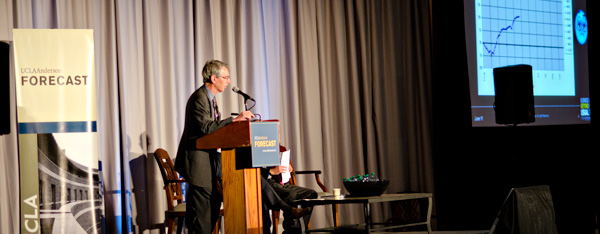|
| Press Release |
UCLA Anderson Forecast: U.S. Economy Growing But "No Recovery In Sight"
In California, slow growth through 2011
|
| |
| |

|
Los Angeles, CA - In its second quarterly report of 2011, the UCLA Anderson Forecast acknowledges a steadily growing Gross Domestic Product, but says that the current level of growth falls short of the levels necessary for a true recovery in the national economy. The California forecast echoes and reinforces the March '11 release, calling for slow growth through the end of the year as the state attempts to re-generate the 1.3 million jobs lost in the recession while also finding work from new entrants to the labor force.
The National Forecast
In his June 2011 report, UCLA Anderson Forecast Director Edward Leamer predicts "normal growth" for the U.S. economy through 2013, with "normal" defined as "3% GDP growth with payrolls growing at 150,000-200,000 per month and unemployment stuck at high levels." But "normal" does not equate to a "recovery." In the report, titled "No Recovery In Sight," Leamer differentiates between normal growth and the type of growth necessary for real recovery from the recent recession. In a "recovery," the economy would experience "5-6% growth with payrolls growing at 250,000-300,000 per month and unemployment falling noticeably." The differentiation is not a matter of semantics. Leamer notes that a recovery is not simply a matter of the economy returning to where it was when the recession began; instead it's a return to trend - a matter of the economy getting to where it would have been had there been no recession - and that requires more than 3% GDP growth.
Leamer identifies the "personal consumption expenditures" (PCE) segment of GDP as a key sector preventing normal growth from rising to recovery, with the housing and automobile sectors the major culprits. "In summary," Leamer writes, "this economic illness is concentrated in the postponable components of GDP: home building and housing services, consumer durables and transportation services and producer durables." In sum, until consumers start buying homes and cars, the recovery remains in the future. On the employment front, Leamer believes that a robust job recovery is prevented by permanent displacements of millions of workers whose jobs are now performed by a combination of technological advances and low-wage foreign workers, along with construction and retail jobs that are not likely to return. "In other words, we have as many as 5.5 million workers who are permanently displaced and only about 3 million that are likely to be recalled," Leamer said, "That's a tough problem which is largely unresponsive to the fiscal and monetary medicine we have been taking. It is likely to take a very long time for those 5.5 million displaced workers to find jobs again, and in the meantime the economy will grow, but not as robustly as in traditional recoveries when the recalls were almost 100%."
The California Forecast
California's forecast, authored by Senior Economist Jerry Nickelsburg, remains substantially the same as it was in March - a continuing period of slow growth with stress in the labor markets. In his report, titled "A Breather in the Process of Recovery," Nickelsburg cites two key elements impeding California's recovery. The first lies in the national forecast, which calls for slower growth in consumer spending. The second is a shift occurring in the residential construction sector.
The forecast calls for 1.7% employment growth in 2011, 2.4% in 2012 and 3.1% in 2013. Unemployment will continue to fall through the year, averaging 11.7% in 2011. Employment growth won't push the unemployment rate below double-digits until the second quarter of 2013, reaching 9.2% by the end of that year. Real personal income growth is forecast to be 1.7% in 2011, and 3.3% and 3.8% in 2012 and 2013 respectively.
The shift in residential construction is rooted in demographics and geography. The demographic shift, confirmed by the 2010 Census suggests a significant shift in demand towards condominiums and apartments. As a result, future construction will move towards multi-family units. This hurts inland California in three ways. First, workers are less likely to move inland into an apartment and commute towards the coast. Secondly, fewer construction workers are required to build multi-family units and thirdly, the inland areas of California are more dependent on construction to fuel its regional economy than coastal areas. Taken together, these shifts are going to be a significant drag on inland California economies that in turn becomes a drag on the state's economy as a whole.
About UCLA Anderson Forecast
UCLA Anderson Forecast is one of the most widely watched and often-cited economic outlooks
for California and the nation and was unique in predicting both the seriousness of the
early-1990s downturn in California and the strength of the state's rebound since 1993. More
recently, the Forecast was credited as the first major U.S. economic forecasting group to
declare the recession of 2001.
About UCLA Anderson School of Management
UCLA Anderson School of Management, established in 1935, is regarded among the very best
business schools in the world. UCLA Anderson faculty are ranked #1 in "intellectual capital"
by BusinessWeek and are renowned for their teaching excellence and research in advancing
management thinking. Each year, UCLA Anderson provides management education to more than 1,600
students enrolled in MBA, Executive MBA, Fully-Employed MBA and doctoral programs, and to more
than 2,000 professional managers through executive education programs. Combining highly
selective admissions, varied and innovative learning programs, and a world-wide network of
35,000 alumni, UCLA Anderson develops and prepares global leaders.
|
| |
|
|

